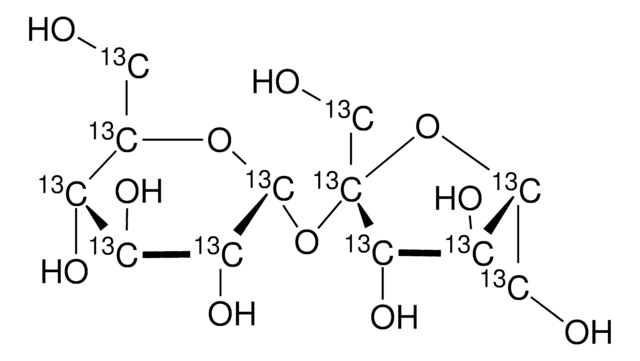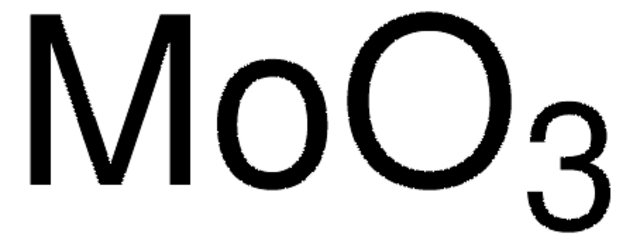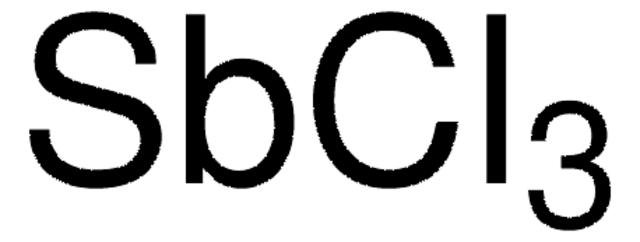637173
Antimony(III) oxide
nanopowder, <250 nm particle size (TEM), ≥99.9% trace metals basis
Sinonimo/i:
Diantimony trioxide
Autenticatiper visualizzare i prezzi riservati alla tua organizzazione & contrattuali
About This Item
Formula condensata:
Sb2O3
Numero CAS:
Peso molecolare:
291.52
Numero CE:
Numero MDL:
Codice UNSPSC:
12352302
eCl@ss:
38080202
ID PubChem:
NACRES:
NA.23
Prodotti consigliati
Saggio
≥99.9% trace metals basis
Forma fisica
nanopowder
Impiego in reazioni chimiche
reagent type: catalyst
core: antimony
Area superficiale
15.6 m2/g , typical
Dimensione particelle
<250 nm (TEM)
P. eboll.
1550 °C (lit.)
Punto di fusione
655 °C (lit.)
Densità bulk
0.5‑0.6 g/mL
Stringa SMILE
O=[Sb]O[Sb]=O
InChI
1S/3O.2Sb
ADCOVFLJGNWWNZ-UHFFFAOYSA-N
Cerchi prodotti simili? Visita Guida al confronto tra prodotti
Avvertenze
Warning
Indicazioni di pericolo
Consigli di prudenza
Classi di pericolo
Carc. 2
Codice della classe di stoccaggio
11 - Combustible Solids
Classe di pericolosità dell'acqua (WGK)
WGK 1
Punto d’infiammabilità (°F)
Not applicable
Punto d’infiammabilità (°C)
Not applicable
Dispositivi di protezione individuale
Eyeshields, Gloves, type P3 (EN 143) respirator cartridges
Scegli una delle versioni più recenti:
Possiedi già questo prodotto?
I documenti relativi ai prodotti acquistati recentemente sono disponibili nell’Archivio dei documenti.
I clienti hanno visto anche
G P White et al.
Journal of occupational medicine. : official publication of the Industrial Medical Association, 35(4), 392-395 (1993-04-01)
An employee at a brazing rod manufacturing plant developed a generalized eruption of follicular papules and pustules. His job tasks included breaking up antimony ingots and melting the pieces in a crucible; he was exposed to antimony metal dust and
Ivo Iavicoli et al.
Journal of trace elements in medicine and biology : organ of the Society for Minerals and Trace Elements (GMS), 16(1), 33-39 (2002-03-07)
Antimony trioxide (Sb2O3) is used as a flame retardant in the textile industry. We carried out a study in a factory for the evaluation of antimony (Sb) occupational exposure and urinary levels in workers exposed to Sb2O3. Urinary levels and
R O Jenkins et al.
Human & experimental toxicology, 17(4), 231-238 (1998-06-09)
1. The aerobic filamentous fungus S. brevicaulis IMI 17297 methylated antimony from Sb2O3 substrate, with the formation of gaseous trimethylantimony (TMA). No evidence was found for the generation of other gaseous antimony compounds by this organism. 2. Biovolatilization of inorganic
Wook Jo et al.
Acta crystallographica. Section A, Foundations of crystallography, 63(Pt 3), 229-233 (2007-04-17)
The composition planes of the inversion boundary induced by the addition of Sb2O3 to ZnO ceramics were analyzed crystallographically by the application of electron back-scattered diffraction (EBSD) analysis and stereographic projection techniques. The inversion boundary was determined to consist of
Anal K Jha et al.
Biotechnology journal, 4(11), 1582-1585 (2009-10-22)
A low-cost green and reproducible microbe (Lactobacillus sp.)-mediated biosynthesis of Sb(2)O(3) nanoparticles is reported. The synthesis was performed at around room temperature. X-ray and transmission electron microscopy analyses were performed to ascertain the formation of Sb(2)O(3) nanoparticles. X-ray analysis indicated
Il team dei nostri ricercatori vanta grande esperienza in tutte le aree della ricerca quali Life Science, scienza dei materiali, sintesi chimica, cromatografia, discipline analitiche, ecc..
Contatta l'Assistenza Tecnica.









